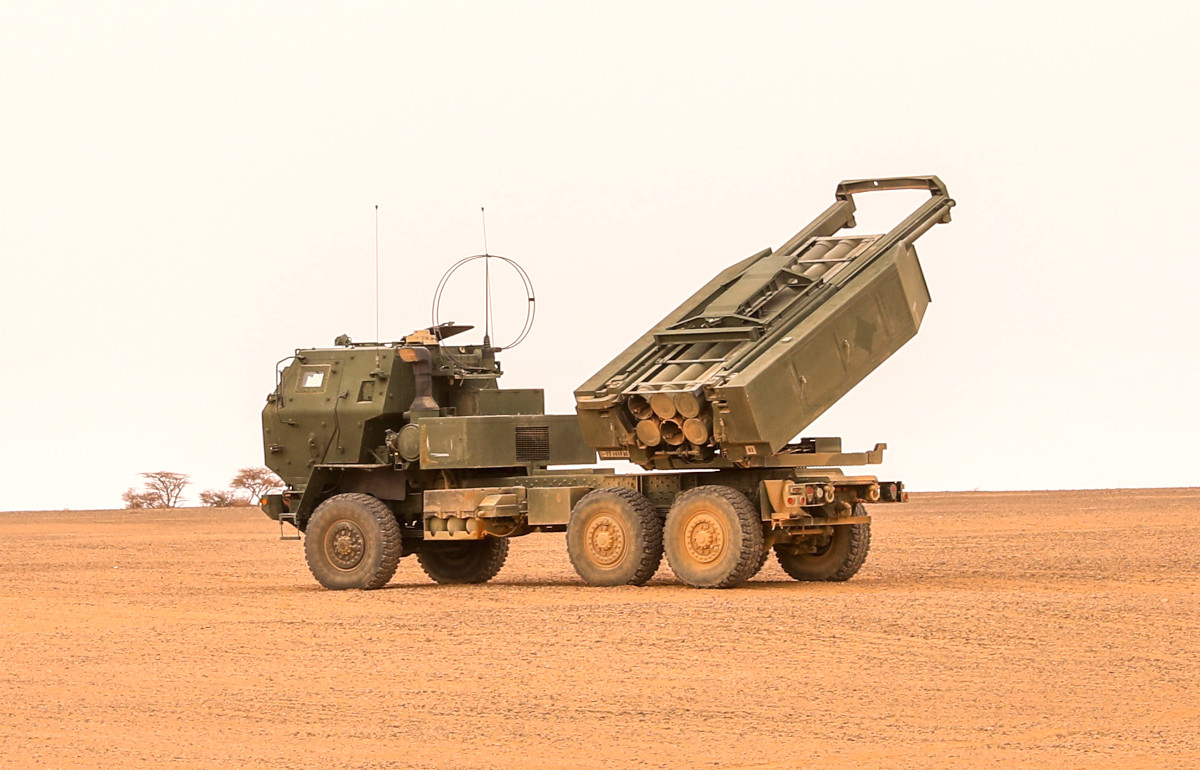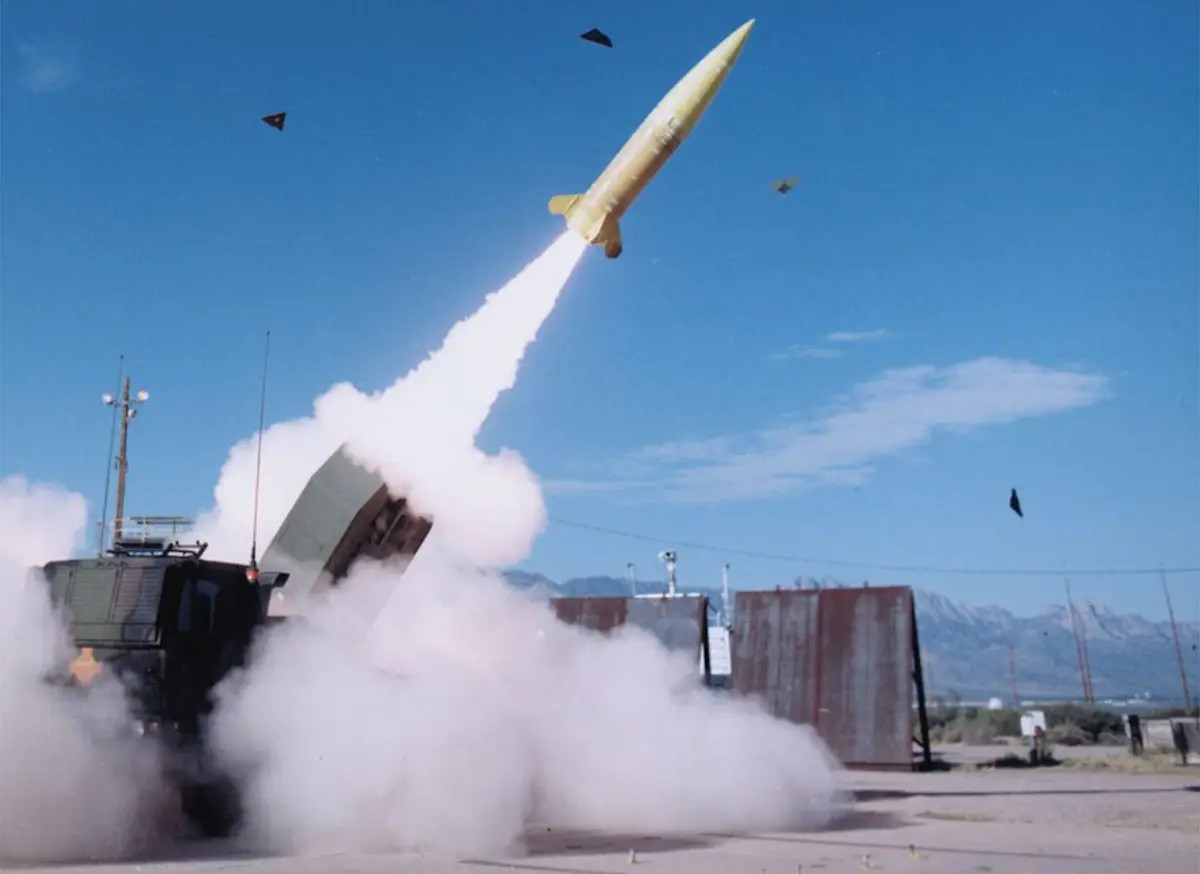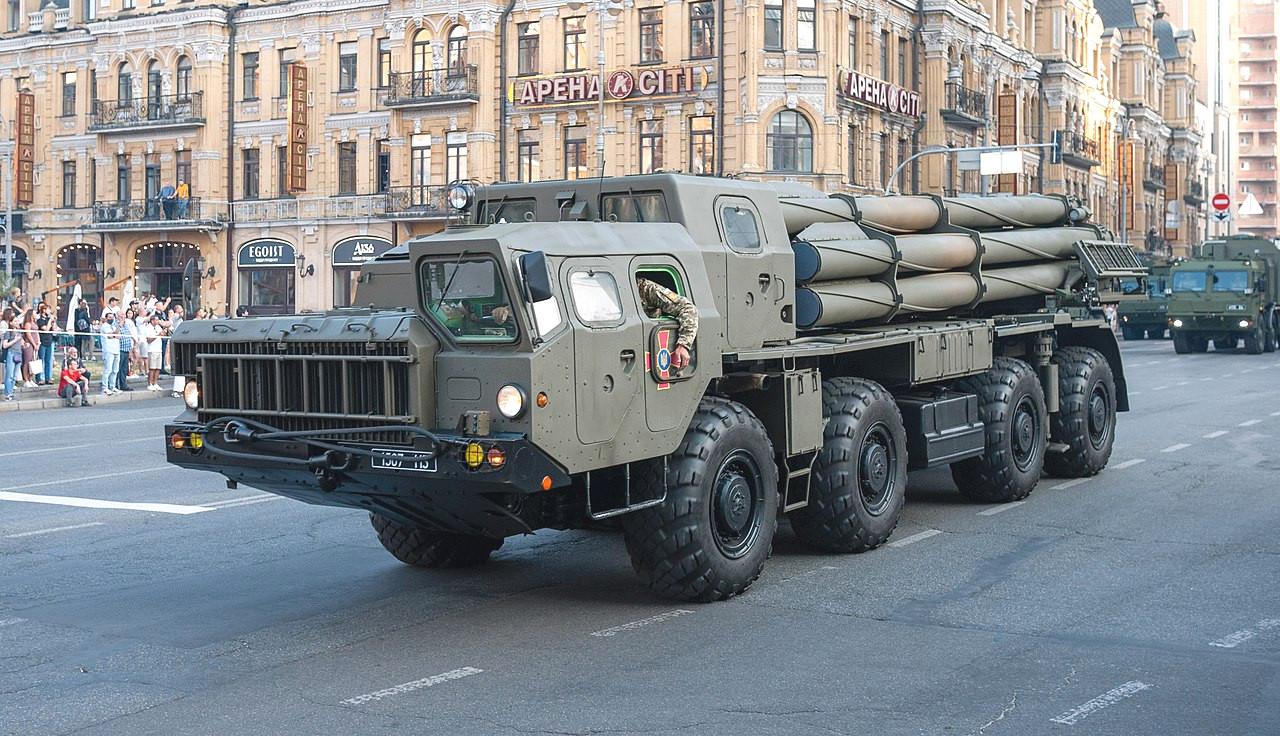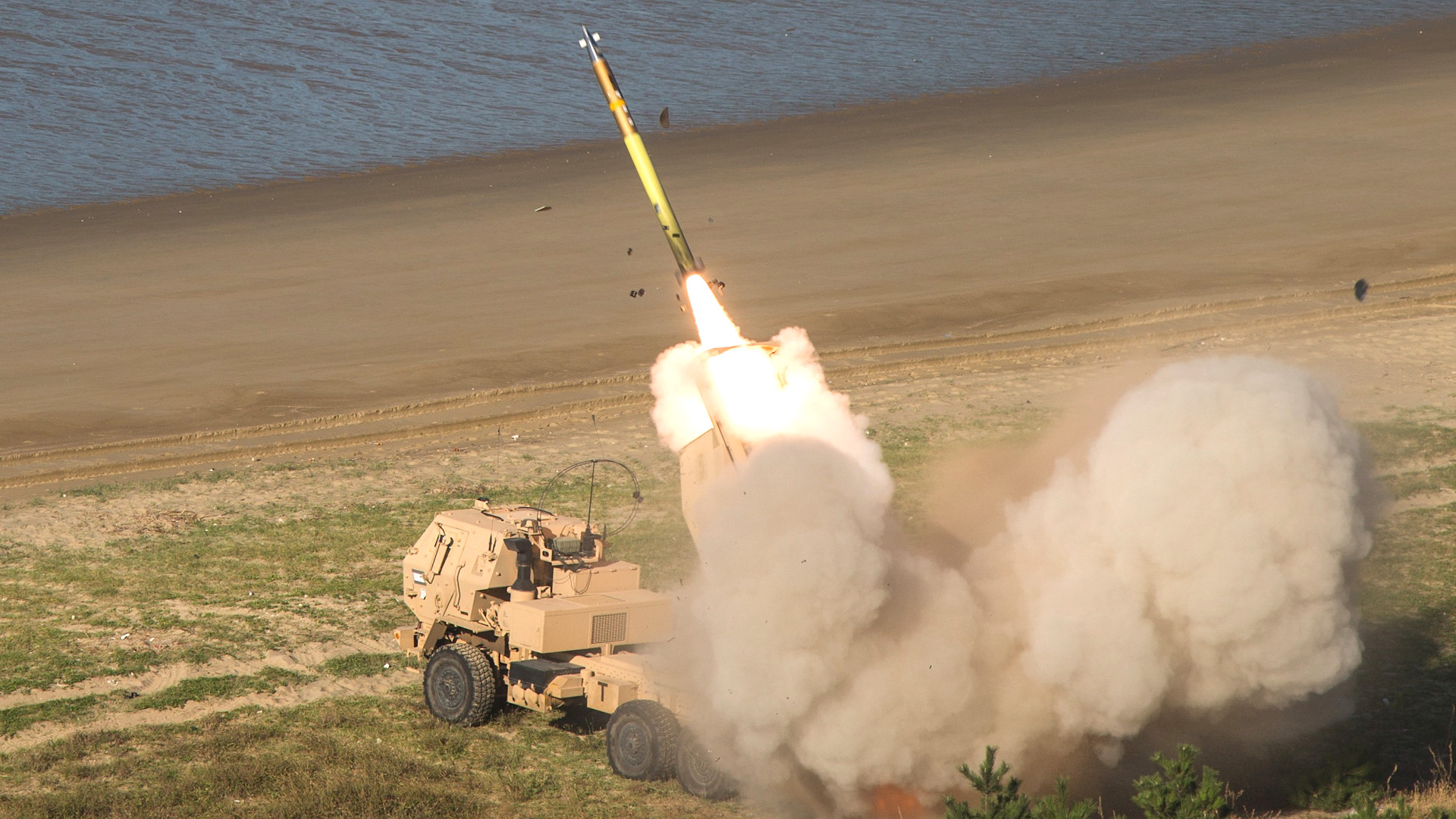U.S. President Joe Biden’s administration is leaning toward sending U.S.-made rocket artillery systems, such as the M142 High Mobility Artillery Rocket Systems, or HIMARS, to the Ukrainian military as part of a new military assistance package, according to a new report from CNN. A transfer of HIMARS to Ukraine could certainly be a much-needed boon for the country’s armed forces, but it wouldn’t necessarily have an instant game-changing impact on the conflict as some have suggested. Here’s the reality of what it can provide and what it can’t.
CNN’s story says the next major military aid package for Ukraine could include HIMARS or the M270 Multiple Launch Rocket System (MLRS), both of which can fire the same family of 227mm artillery rockets, as well as Army Tactical Missile System (ATACMS) short-range ballistic missiles. A public announcement could come as soon as next week. This follows recent successes by the Russian military in Ukraine’s eastern Donbas region, thanks in no small part to massed artillery fire.
“I don’t want to discuss specific systems in this forum,” U.S. Secretary of Defense Lloyd Austin said earlier this week at a press conference in response to a question specifically about sending M142s to Ukraine. “We’ll engage the international community to make sure to get as much capability against those requirements as possible.”
In the context of the current conflict, the possibility of Ukraine acquiring HIMARS has been a topic of active discussion since at least April. That month rumors began to swirl that the U.S. had sent some of these systems based on an interview that Victoria Nuland, U.S. Under Secretary of State for Political Affairs, gave to Ukraine’s Ukrayinska Pravda newspaper. There is no actual evidence that the Ukrainian armed forces have received any HIMARS so far and considering recent news, this is clearly not the case.
Ukrainian officials, including President Volodymyr Zelensky, as well as experts and observers, have repeatedly called directly and indirectly for the U.S. military to send M142s, or M270s, to help with the war effort. A Tweet just yesterday, seen below, from Mykola Bielieskov, a Research Fellow at the Ukrainian government-run National Institute for Strategic Studies, sums up the general argument well. Bielieskov’s Twitter post was accompanied by a picture of an M270.
The M270 features a launch system mounted on a tracked chassis derived from that of the Bradley infantry fighting vehicle. The launcher can fire a variety of 227mm artillery rockets, including precision-guided types, as well as Army Tactical Missile System (ATACMS) short-range ballistic missiles, all of which come preloaded in canisterized ammunition “pods.” A single M270 can be loaded with two of these pods at a time, allowing it to fire up to 12 rockets or two ATACMS missiles before needing to be reloaded.
The M142 features a smaller launch system, which can only hold one pod at a time, mounted on a 6×6 Family of Medium Tactical Vehicles (FMTV) truck chassis. For what the M142 gives up in firepower it makes up in transportability and on-road mobility. It can even be rapidly deployed via a C-130.

The maximum range of either of these systems is dependent on what type of munition they’re firing. The longest range artillery rockets currently available for the system are the M30 (submunition warhead) and M31 (unitary warhead) precision-guided types, which are GPS/INS guided and can hit targets out to around 43 miles (70 kilometers). The far larger ATACMS missiles can engage threats out to 186 miles (300 kilometers) depending on the variant.
To be sure, a Ukrainian military acquisition of either the M270 or the HIMARS presents clear benefits. The most immediate of these would be fielding a new artillery rocket system that is in production and has a well-established supply chain in place in the West. At present, the bulk of Ukraine’s rocket artillery capability comes from Soviet-era designs, some of which have been modernized by domestic companies over the years. The Ukrainian armed forces have now received a number of RM-70 multiple rocket launchers (MRL) from the Czech Republic, but these are still Cold War-era systems designed to fire Soviet-standard 122mm rockets. They also use a wide range of other Soviet-era artillery rocket systems.
From a tactical perspective, MLRS and HIMARS are likely to be generally more accurate systems, even with unguided rockets, than any of the rocket artillery systems that are currently in Ukrainian service. The fact that the same launcher can fire ATACMS gives it additional flexibility and a true long-range standoff precision capability beyond the limitations of traditional MRLS.
At the same time, various factors could impose limitations on the utility of any M270s or M142 delivered to Ukraine, especially early on in their service.
For instance, precision-guided 227mm rockets and ATACMS missiles are not ideally employed in mass volleys against broad area targets, such as the enemy armor or artillery formations that Ukrainian forces are staring down in the Donbas region. Any stocks of guided munitions that get sent along with the launchers could very well be small in quantity, at least initially, anyway. It is not hard to imagine that they would be employed very selectively in instances where the extended range and ability to hit pinpoint targets could be best exploited, with more traditional rockets still providing massed fires against hostile forces. In a pinch, the M30/31s can be used against massed targets, and less rockets are needed to accomplish the intended effects due to their precision, but the precious nature of these weapons would likely only see them used in that manner during dire circumstances.

It’s also not clear from CNN’s report or any other sources how willing or able the U.S. government would be to send guided 227mm rockets or ATACMS missiles, to begin with. The technology inside those weapons, as well as the highly-automated launcher itself, could prompt concerns about operational security risks in the event they might be captured by Russian forces. The War Zone has itself already highlighted how Russia’s materiel losses in the conflict have almost certainly translated into major intelligence gains for the West.
The U.S. military has notably transferred a number of 155mm M777A2 towed howitzers to Ukrainian forces already, but without the networked digital fire control system that is present on those weapons in American service. This also means that those howitzers cannot employ precision-guided shells and limits how quickly and accurately they can engage a target or shift focus to another.
Video footage did emerge this week that reportedly shows additional M777A2s being trucked into Ukraine from Poland that do feature the fire control system, which could indicate a shift in policy in this regard.
The Missile Technology Control Regime (MCTR), a voluntary international arms control pact that the United States and Ukraine are parties to, presents potential hurdles for the transfer of ATACMS missiles at all. The MTCR is particularly focused on curtailing exports of missiles with ranges of 300 kilometers (186 miles) or more and/or with payloads weighing 500 pounds or more, which includes all ATACMS variants with the exception of the MGM-140B. In addition, in U.S. military service, MGM-140Bs were also often loaded with lighter warheads to increase their maximum range to 300 kilometers.
It’s also worth noting that there are, at least presently, the only unguided rockets available for the MLRS and HIMARS are loaded with cluster munitions warheads. The submunitions in these warheads, M77 or M85 Dual-Purpose Improved Conventional Munitions (DPICM) depending on the exact variant, have a long history of questionable reliability. Unexploded submunitions can present serious hazards to the safe movement of friendly forces, as well as enemy units, not to mention innocent bystanders.
U.S.-supplied rockets loaded with cluster munitions might raise political, as well as pragmatic issues for Ukraine. The Russian military has been actively criticized for its often indiscriminate employment of cluster munitions, as well as other weapons, in the conflict so far. At the same time, Ukrainian forces have reportedly used their own cluster munitions in the fighting. To date, Russia, Ukraine, and the United States remain among the countries that have declined to sign an international agreement that prohibits the production, stockpiling, and employment of certain cluster munitions.
Questions of the political optics aside, without precision-guided rockets, let alone ATACMS missiles, MLRS and HIMARS would not necessarily offer the Ukrainian military significant new artillery capabilities over the MRLs it has in service now. Unguided M26-series 227mm rockets would certainly offer improved accuracy and range over the 122mm systems, versions of the Soviet-era BM-21 Grad and the more recently acquired RM-70s, that the Ukrainian armed forces currently possess.
However, the longest-range variants of the M26 do not offer dramatically greater capability in terms of reach than the 220mm types fired from larger Ukrainian BM-27 Uragans and cannot reach the same distances that their existing 300mm ones their BM-30 Smerchs employ can. The rockets available for the BM-27 can generally hit targets out to almost 22 miles (35 kilometers), while most of the types that the BM-30 fires can engage threats up to 43 miles (70 kilometers) away. The extended-range M26A1/A2 rocket types have a maximum range of just under 28 miles (45 kilometers).

Russia has BM-27 and BM-30 MRLs and has been using them in Ukraine. The U.S. military itself has previously cited the range of the BM-30, among other Russian artillery systems, as one of the driving factors behind efforts to develop new extend-range rockets for HIMARS and the M270.
Precision-guided 233mm M30 and M31 rockets for HIMARS and MLRS, on the other hand, offer ranges that can compete with BM-30 Smerch and can do so with pinpoint accuracy, which the Smerch cannot. In some cases, this can come in very handy, especially when hitting critical or time-sensitive targets, such as enemy command posts, or as a last resort for taking out or degrading Russia’s longest-range artillery systems. The guided rockets can also act as close fire support for troops downrange, which would be very helpful in danger-close situations, especially considering Ukraine has very limited close air support options and especially those of a precision nature.
ATACMS is a whole other animal. It would give Ukraine the ability to make long-range pinpoint strikes even against hardened targets over nearly 200 miles. Arming the Ukrainian Army with this capability would be the biggest escalation in arms transfers since the start of the war and would allow Ukraine to make precision strikes deep into Russian territory. While a week ago, the idea of arming Ukraine with ATACMs seemed highly remote, the fact that NATO is now supplying Ukraine with RGM-84 Harpoon anti-ship missiles sets a new precedent. Still, ATACMs — a land attack ballistic missile — would be a major step beyond that.
Finally, we must underscore again that the precision rockets these systems can fire are expensive, potentially sensitive in terms of technological risk, and would only be available in limited numbers, if at all. This would limit their impact on the battlefield. But even supplying Ukraine with MLRS or HIMARS and unguided rockets would provide a more accurate capability and an assured supply chain via being able to draw down ammunition from U.S. stocks.
And of course, Ukrainian forces would welcome MLRS or HIMARS deliveries and could put them to good use. Artillery, in general, is providing to be a particularly critical asset on both sides in the current fighting in Ukraine’s eastern Donbas region. Any additional artillery support capacity could help Ukraine’s military to help stave off Russian advances.
At the same time, MRLS or HIMARS, in the configuration that they would most likely arrive in and with the types and quantities of ammunition that they are most likely to be supplied with, at least initially, may not provide the kinds of instant tide-turning capabilities that many people might be hoping for, but that shouldn’t be the point. They are another tool in a growing toolbox that will give Ukraine more tactical options and overall lethality, even if the upgrade is incremental in nature.
UPDATE: 5/31/2022—
In an op-ed published by The New York Times, U.S. President Joe Biden has confirmed that the U.S. government will transfer to the Ukrainian military “more advanced rocket systems and munitions that will enable them to more precisely strike key targets on the battlefield.” Separately, a senior U.S. official briefing reporters ahead of a more formal announcement scheduled to occur on June 1 further confirmed that the weapon systems in question were M142 High Mobility Artillery Rocket Systems (HIMARS).
It remains unclear exactly what types of munitions will be included along with the HIMARS launchers. It’s also not clear if other items will be included in the complete military assistance package, which is valued at approximately $700 million in total.
The senior U.S. official said that American authorities have received assurances from their Ukrainian counterparts that the HIMARS systems will not be used to strike targets inside Russia. It has not yet been clarified whether or not this stipulation covers areas of Ukraine that Russia occupies, but considers to be its territory, namely the Crimean Peninsula, or breakaway regions that the government in Moscow has recognized as independent countries.
“We do not seek a war between NATO and Russia. As much as I disagree with Mr. Putin, and find his actions an outrage, the United States will not try to bring about his ouster in Moscow,” Biden wrote in his op-ed. “We are not encouraging or enabling Ukraine to strike beyond its borders.”
“We currently see no indication that Russia has intent to use nuclear weapons in Ukraine, though Russia’s occasional rhetoric to rattle the nuclear saber is itself dangerous and extremely irresponsible,” the U.S. President added, addressing fears about escalation and the potential for direct conflict with Russia that have been raised on multiple occasions, including in connection with the delivery of weapons like HIMARS to Ukraine. “Let me be clear: Any use of nuclear weapons in this conflict on any scale would be completely unacceptable to us as well as the rest of the world and would entail severe consequences.”
Contact the author: joe@thedrive.com and Tyler@thedrive.com
